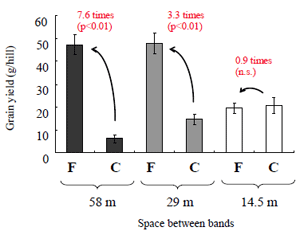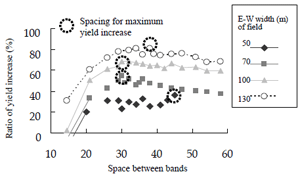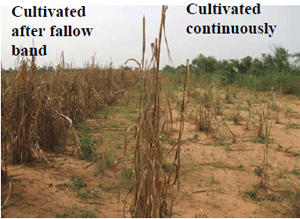The “Fallow Band” System: A proposed new low-input technology option contributing both to the prevention of desertification and the increase of pearl millet yield in the Sahel, West Africa
Description
Wind erosion is a major cause of the spreading desertification in the Sahel region of West Africa. Our previous studies showed that wind erosion induces the loss of a significant amount of relatively fertile materials from the surface of crop fields. We have also revealed that the wind-eroded soil materials can be captured by leeward herbaceous fallow vegetation. With application of these findings, we have developed a new agricultural practice, called the “Fallow Band” system, for combating the expansion of desertification in the Sahel.
The outline of the “Fallow Band” system in a temporal sequence of land use is shown in Fig. 1. (A) Five -meter-wide fallow bands are arranged at a right angle to the direction of erosive storms (East wind) in a cultivated field during the rainy season. Then fallow bands can be easily created by skipping the usual seeding and weeding. Crops (pearl millet) are cultivated in other areas of the field in a conventional way. The fallow bands are also maintained in the next dry season, so they are expected to catch wind-blown materials containing a lot of nutrients. (B) In the next rainy season, new fallow bands are made aside from the former bands toward the direction of the wind. Vegetation on the previous fallow bands are cleared away and crops are cultivated on it as well as in other areas of continuous cultivation. (C) Repeat (B) every year.
The “Fallow Band” system was actually applied to farmers’ pearl millet fields in Katanga Village, Koro Prefecture, Niger (Photo 1), and its effects on prevention of wind erosion and on improving the millet yield were evaluated. The results were shown as below: i) The efficiency of a fallow band to capture wind-blown soil materials was estimated to be 74%. ii) Millet yield on the former fallow bands was higher when the spacing between the bands was widely arranged (Fig. 2). iii) The positive effect of fallow bands on millet yield continued at least two years after clearance of the vegetation (data not shown). iv) Based on the data described in i), ii) and iii), and assuming that the effect continues no longer after the third year, the ratio of yield increase was simulated as functions of the field size (E-W length) and the band spacing (Fig. 3). On a whole field basis, the yield was estimated to be increased by 36% (small field) to 81% (large field) as compared with the area not applied with the “Fallow Band” system. v) Also, wind erosion was reduced by 52% (small field) to 80% (large field) on a whole field basis with application of the system (data not shown).
A quantitative evaluation showed that the “Fallow Band” system can be useful both for the prevention of desertification and the increase of pearl millet yield in the Sahel, West Africa. It is worthy to note that this novel practice does not impose any additional labor, resource or money requirements on the local farmers.
Figure, table
-
Fig. 1. Outline of the “Fallow Band” system with temporal sequence of the arrangement of fallow bands and cultivation areas. -
Fig. 2. Grain yield of pearl millet cultivated on the previous fallow bands (F) of different spacing, as compared with that cultivated continuously (C) -
Fig. 3. Simulated results on the ratio of yield increase on a whole field basis as functions of the width of the field and the fallow band spacing applied.
Theoretical maximum yield increase was indicated in each width of field. -
Photo 1. A view of the pearl millet field applied with the “Fallow Band” system at harvest.
Left row: Cultivated after one year fallow band, Right row: Cultivated continuously.
- Affiliation
-
Japan International Research Center for Agricultural Sciences Crop Production and Environment Division
-
Kyoto University
- Term of research
-
FY2006~2008
- Responsible researcher
-
IKAZAKI Kenta ( Kyoto University )
KAKEN Researcher No.: 70582021SHINJO Hitoshi ( Kyoto University )
ORCID ID0000-0002-7244-9558KAKEN Researcher No.: 70359826TANAKA Ueru ( Kyoto University )
KAKEN Researcher No.: 10231408TOBITA Satoshi ( Crop Production and Environment Division )
- ほか
- Publication, etc.
-
Ikazaki et al. (2008) Research for tropical agriculture 1 (Extra issue), 41-42.
Ikazaki, K. Shinjo, H., Tanaka, U., Tobita, S. and Kosaki, T. (2009) Sediment catcher to trap coarse organic matter and soil particles transported by wind. Transactions of the ASABE 52(2). (accepted)
- Japanese PDF
-
2008_seikajouhou_A4_ja_Part10.pdf535.27 KB




